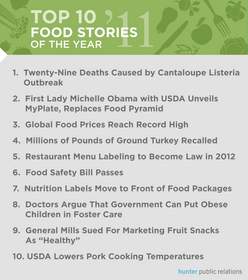NEW YORK, NY--(Marketwire - Dec 8, 2011) - Food safety tops the list of an annual survey asking Americans to choose the most significant food story of 2011. Even in a year when global food prices hit record highs and both restaurant menus and retail food labels got a new look, the safety of the American food supply dominated the headlines and consumers took notice. The survey was commissioned by Hunter Public Relations, a leading public relations agency specializing in the food and beverage industry.
Now in its ninth year, the Hunter PR food survey provides a look back at the top food-related stories of each year. To compile the 2011 list, the Hunter PR Food Group collaborated with industry experts, including Phil Lempert, editor of Supermarket Guru; Regina Ragone, food director of Family Circle; Elizabeth Fassberg, owner of food and nutrition consultancy Eat Food; Brad Thompson, chef and restaurant consultant; and Megan Steintrager, freelance food writer and editor. After polling 1,000 Americans, the following were named the top three food-related stories of 2011:
#1: Twenty-Nine Deaths Caused by Cantaloupe Listeria Outbreak
To date, 29 people have died, and another 133 were made ill from tainted cantaloupe in 2011. Traced to bacteria growing on packing equipment at Colorado's Jensen Farms, the incident is already the second largest listeria outbreak in U.S. history.
#2: First Lady Michelle Obama with USDA Unveils MyPlate, Replaces Food Pyramid
For the second year in a row, First Lady Michelle Obama was part of one of the top food stories of the year. Together with the USDA, she revealed MyPlate, the new dietary guidelines campaign, replacing the 20-year-old food pyramid.
#3: Global Food Prices Hit Record High
The number three spot finds its home at the intersection of food and finance: global food prices skyrocketed in 2011, putting pressure on the restaurant, travel and hotel industries. To avoid passing costs to consumers, companies are scrambling to renegotiate contracts, find cheaper suppliers and reconfigure menus.
The survey also revealed how consumer behavior was impacted by these stories and how these stories will affect Americans in the coming year.
Digesting Food News
- Sixty-one percent of survey respondents changed their food habits in 2011 because of news coverage.
- The most common change in behavior was paying more attention to the foods they eat (47 percent).
- Forty-five percent of Americans who were influenced by a food story decided to cook and eat more at home.
- Twenty-nine percent of people surveyed now pay extra attention to the nutritional value of restaurant foods.
New Year, Nu-tritional You
- In 2012, 67 percent of Americans will make food-related resolutions.
- Approximately half (47 percent) of these resolutions will address eating more whole grains or drinking beverages with less sugar.
- Fourteen percent of Americans 18 and older (roughly 33 million Americans) will continue 2011's trend of incorporating less meat into their diets.
- Twenty-one percent of folks promise to pay more attention to labels on packaged foods.
Click here for the complete list of the 10 most significant food stories of 2011.
Join the conversation of the top food stories of 2011 at a special Twitter party hosted by The Hunter PR Food Group on Thursday, December 15th from 9 p.m. to 10 p.m. EST. You can follow the discussion via #HunterPRFood. Follow @HunterPR for more information.
ABOUT THE SURVEY
The ninth annual year-end food survey was commissioned by Hunter Public Relations, one of the nation's leading public relations agencies serving the food and beverage industry. Hunter PR enlisted Wakefield, an independent market research firm, to survey 1,000 Americans ages 18 years and older via an email invitation and online survey. Quotas have been set to ensure reliable and accurate representation of the U.S. population ages 18 years and older. Results of any sample are subject to sampling variation. For the interviews conducted in this particular study, the chances are 95 in 100 that a survey result does not vary, plus or minus, by more than 3.1 percentage points from the result that would be obtained if interviews had been conducted with all persons in the universe represented by the sample.
Links
Video
Contact Information:
CONTACT:
Amanda Brokaw
Hunter Public Relations
abrokaw@hunterpr.com
(212) 679-6600 ext. 210
